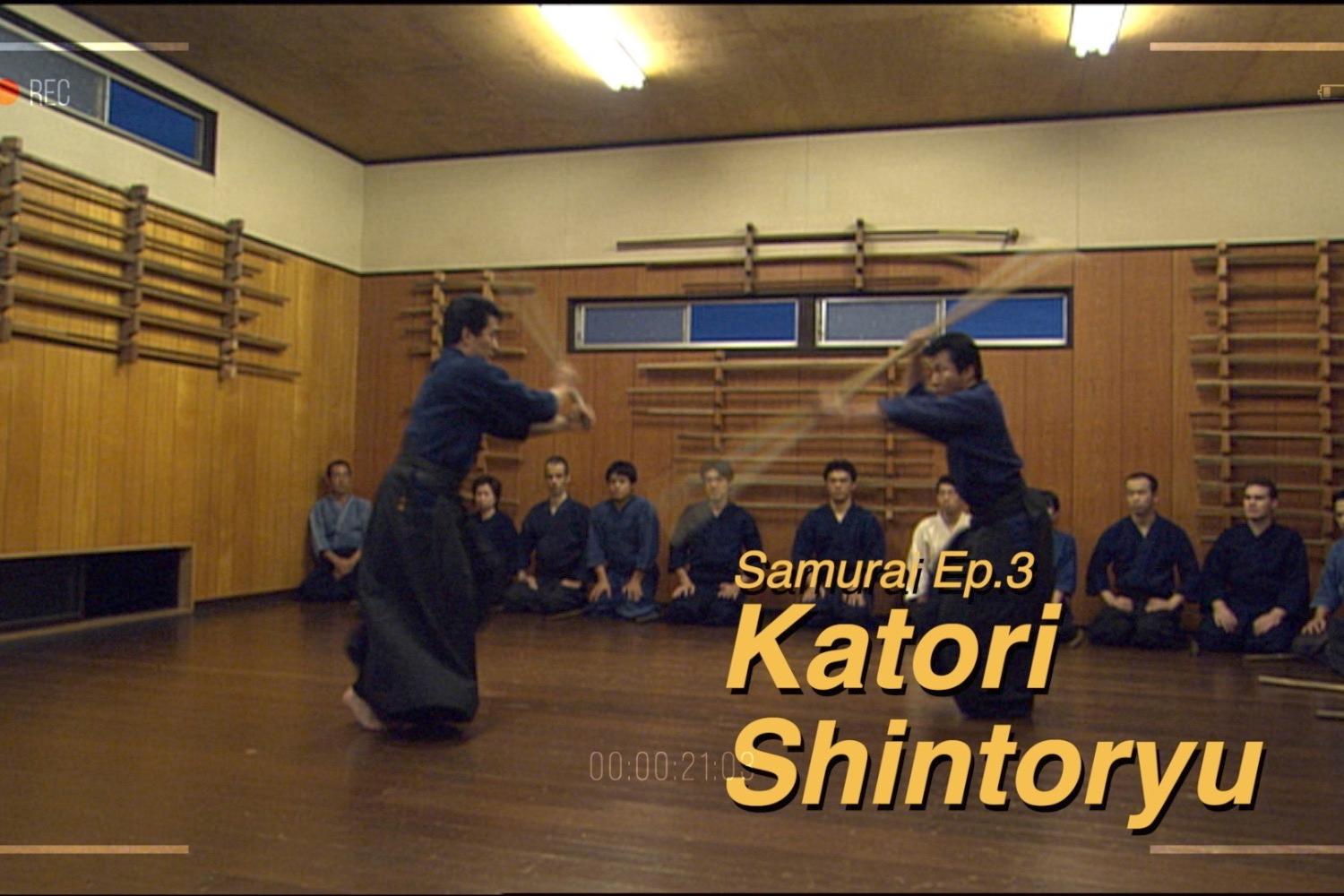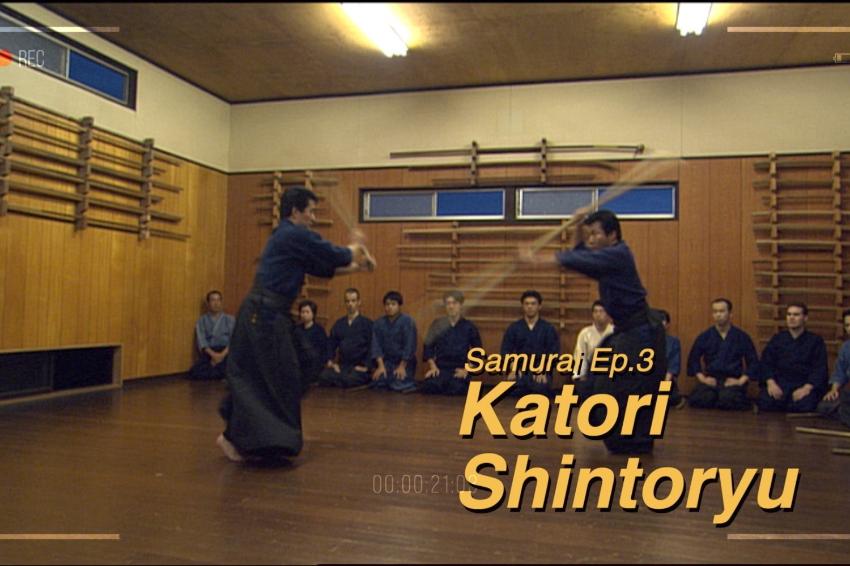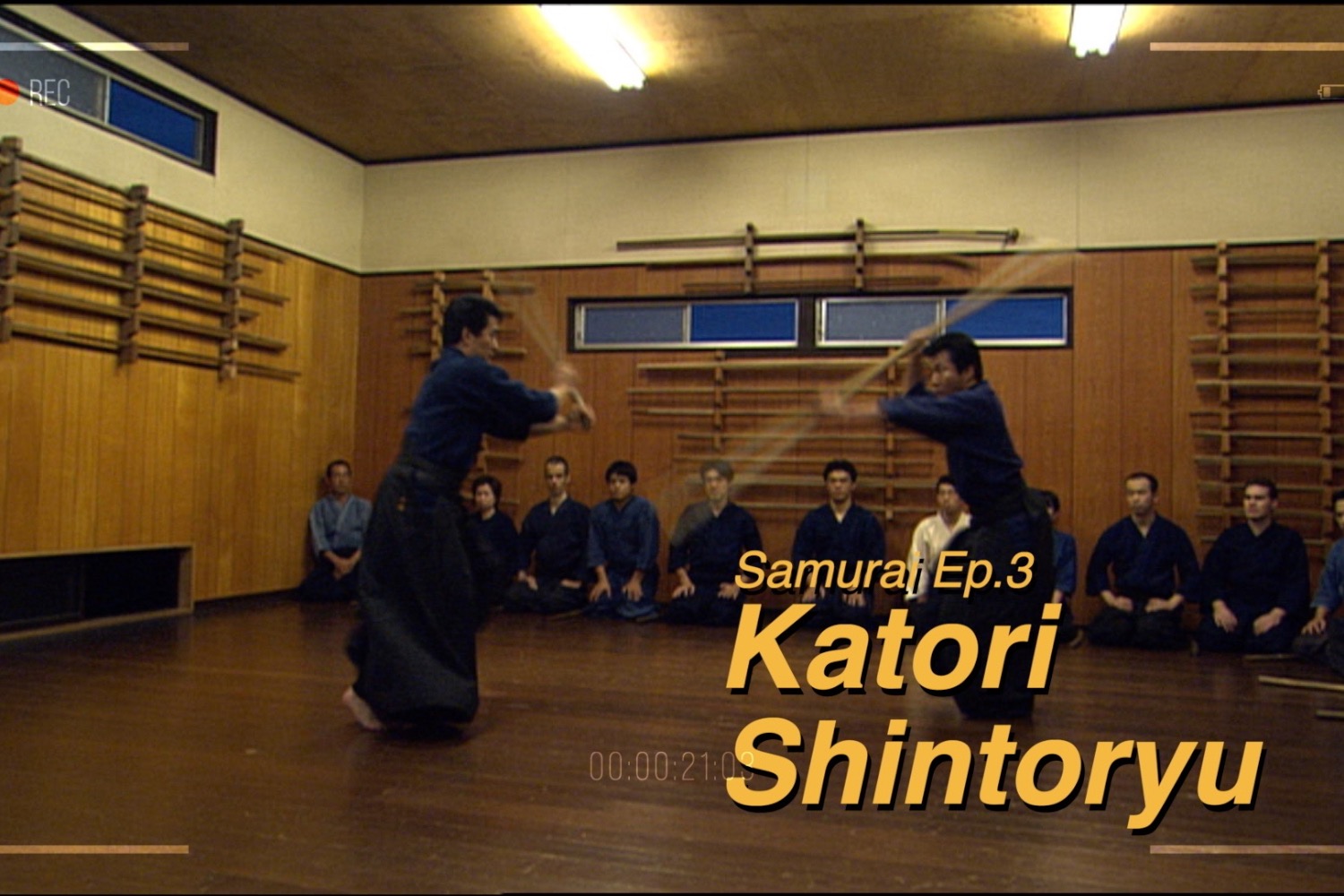2003년 다큐멘터리
생활 속의 무술
무사(武士)
3화 [일본 무술의 원류를 찾아서2 - 카토리신토류(香取神道流)]
- 가토리 신토류 종가
일본무술이 본격적으로 체계화 된 것은 15세기 가토리 신토류에 이르러서였다.
치바현의 3백년된 종가는 가토리 신토류의 역사를 전하고 있다.
- 이이자사 쵸이사이 이에나오 그림
가토리 신토류의 창시자 이에나오. 이이자사 쵸이사이 이에나오(飯篠長威斎家直)
무사(武士)의 아들로 태어난 그는 어릴때부터 검술과 창술에 능했다.
청장년 시절엔 전장에서 수많은 공적을 남겼고, 창술은 신기의 경지에 이르렀다.
- 가토리 신궁(香取神宮)
그런데 그는 갑자기 속세를 떠나 가토리 신궁(香取神宮) 으로 들어간다.
가토리 신궁은 일본의 고대 전쟁신, 후쓰누시노 미코토를 모시는 곳이다.
무사(武士)들은 전쟁에 나가기 전 이곳에 와서 무운을 빌고 길을 떠났다고 한다.
- 오오다 케리스케, 가토리 신토류 사범 인터뷰
(이에나오라는 분이 치바 가문에서 일했는데 치바 가문이 멸망하자60세에 이르러
세상을 등지고 가토리 신궁에서 자신만의 수행의 길을 택했습니다.
천일기도를 드리면서 목욕재개하고 분골수행 끝에 고안해냈습니다.)
- 가토리 신토류 시범
이에나오는 죽기전까지 많은 제자를 양성했다.
가시마 신류, 가시마 신토류, 신가게류 등 유명한 유파가 그의 문하에서 나왔다.
가토리 신토류가 일본 검술의 아버지로 불리는 이유는 이 때문이다.
다른 유파나 현대검도에서는 두세 동작으로 상대를 제압하지만, 신토류에서는 15개에서 20개의 동작을 거친다.
그리고 마지막에는 반드시 케사기리로 상대를 어깨에서부터 허리까지 완전히 베어내린다.
이런 특징은 당시만 해도 전장에서 무거운 갑옷을 입은 상태에서 검술이 이뤄졌기 때문이다.
하지만 평상시 이에나오는 검술을 함부로 사용하지 않았다.
- 오오다 케리스케, 가토리 신토류 사범 인터뷰
(그는 싱글벙글 웃으면서 저렇게 얌전한 모습으로 당신도 이 얼룩조릿대 위에 올라올 수 있으면 시합에 응하겠소.
자 한번 올라오시오라고 말하는 겁니다.
그러면 무예자는 얼룩조릿대 위에 올라가지를 못하는 겁니다. 올라타면 꺽여버리니까요.
그래서 이런 분과는 도저히 시합을 할수 없다며 “죄송합니다. 제가 졌습니다” 라고 물러갔다고 합니다.)
- 가토리 신궁(香取神宮), 절하는 모습
‘싸워서 이기는 것은 진정한 승리가 아니다.
칼을 뽑지 않고 목적을 달성하는 것이 진정한 승리다’는 이에나오의 가르침.
- 일본의 유명 검객들
일본의 유명 검객들에게는 이런 비슷한 이야기들이 흔히 전해진다.
그리고 여기에는 무사(武士)들이 근본적으로 전쟁에서 멀어진 시대적 배경이 자리잡고 있다.
Japanese warrior: Samurai, Episode 3
[Finding the Origin of Japanese Martial Arts 2- Katori Shintoryu]
2003 Documentary, Martial Arts in Life
00:00:02 - Chiba Prefecture Intangible Cultural Property, Katori Shintoryu
00:00:05
00:00:06
00:00:07 It was not until the Katori Shinto-ryu in the 15th century that Japanese martial arts were systematized in earnest.
00:00:14 Chiba Prefecture's 300-year-old head family tells the story of the Katori Shinto-ryu.
00:00:21 - Iisasa Choisai Ienao
00:00:25 the creator of the picture Katori Shintoryu. Born as the son of a warrior, he was good at swordsmanship and spears from an early age.
00:00:34
00:00:35 When he was a young man, he left many achievements on the battlefield, and his spearmanship reached the level of a miracle.
00:00:41
00:00:43 - Katori Jingu
00:00:45
00:00:47 But he suddenly leaves the world and enters Katori Jingu
00:00:55
00:00:58 Katori Jingu Shrine is dedicated to the ancient Japanese god of war, Futsunushi no Mikoto.
00:01:08 It is said that warriors came here to pray for good luck before going to war.
00:01:13 - Katori Jingu Shrine, bowing
00:01:18
00:01:22 - Interview with Keirisuke Oda, Master Shintoryu Katori
00:01:23 (A man named Ienao worked for the Chiba clan, but when the Chiba clan collapsed,
00:01:32 he turned his back on the world at the age of 60 and chose his own path of training at Katori Jingu Shrine.
00:01:36 It was devised after resuming the bath while praying a thousand days of prayer.)
00:01:44
00:01:45 - Katori Shintoryu Dojo
00:01:48 Ienao trained many students until his death.
00:01:53 Famous schools such as Kashima Shinryu, Kashima Shinto-ryu, and Shinga-ryu came out of his school.
00:02:01
00:02:01 This is why Katori Shintoryu is called the father of Japanese swordsmanship.
00:02:08
00:02:11 In other schools and modern kendo, two or three movements are used to subdue the opponent,
00:02:15 but in Shinto-ryu, 15 to 20 movements are used.
00:02:19
00:02:20 -Katori Shintoryu demonstration
00:02:27
00:02:28 And in the end, be sure to cut the opponent down completely from the shoulder to the waist with a kesagiri.
00:02:36 This is because, even at that time, swordsmanship was performed while wearing heavy armor on the battlefield.
00:02:43 However, he did not use the swordsmanship that usually comes out of Ie.
00:02:47
00:02:55 - Interview with Keirisuke Oda and Master Shintoryu Katori
00:02:55 (He smiled and said,
00:02:57 "If you can climb on this stilt pole with that kind of meekness,
00:03:01 I will participate in the match" and "Come on up once more".
00:03:10 Then the martial artist will not be able to climb on the stained slate.
00:03:15 If you climb on it, it will bend.
00:03:18 So he said, "I'm sorry, I can't compete with someone like this.
00:03:22 I lost,” he said and withdrew.)
00:03:25
00:03:26
00:03:31 ‘Winning a fight is not a real victory.
00:03:34 Achieving a goal without drawing a sword is the true victory.” Ienao taught.
00:03:43
00:03:44 Similar stories are often told by famous Japanese swordsmen.
00:03:50 And here lies the background of the times when samurai were fundamentally away from war.
00:03:58







